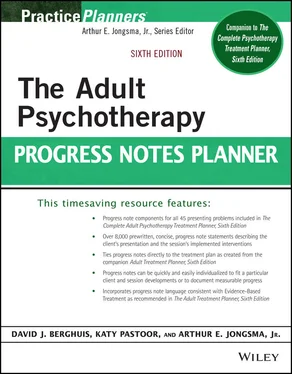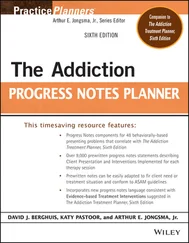9 Assess Severity of Impairment (9)The severity of the client's impairment was assessed to determine the appropriate level of care.The client was assessed in regard to his/her/their impairment in social, relational, vocational, and occupational endeavors.It was reflected to the client that his/her/their impairment appears to create mild to moderate effects on the client's functioning.It was reflected to the client that his/her/their impairment appears to create severe to very severe effects on the client's functioning.The client was continuously assessed for the severity of impairment, as well as the efficacy and appropriateness of treatment.
10 Refer for Medication Evaluation (10)The client was referred to a prescribing clinician to evaluate him/her for psychotropic medication to reduce symptoms of anxiety.The client has completed an evaluation by the prescribing clinician and has begun taking antianxiety medications.The client has resisted the referral to a prescribing clinician and does not want to take any medication to reduce anxiety levels; his/her/their concerns were processed.
11 Monitor Medication Adherence (11)The client's adherence with the clinician's prescription for psychotropic medication was monitored for the medication's effectiveness and side effects.The client reported that the medication has been beneficial to him/her/them in reducing his/her/their experience of anxiety symptoms; the benefits of this progress were reviewed.The client reported that the medication does not seem to be helpful in reducing anxiety experiences; this was reflected to the prescribing physician.The therapist conferred with the prescribing clinician to discuss the client's reaction to the psychotropic medication and adjustments were made to the prescription by the clinician.
12 Discuss Anxiety Cycle (12)The client was taught about how anxious fears are maintained by a cycle of unwarranted fear and avoidance that precludes positive, corrective experiences with the feared object or situation.The client was taught about how treatment breaks the anxiety cycle by encouraging positive, corrective experiences.The client was taught information from Mastery of Your Anxiety and Worry—Therapist Guide (Craske, Barlow, and O'Leary) regarding the anxiety pattern.The client was taught information from the book Treating GAD (Rygh and Sanderson).The client was reinforced as he/she/they displayed a better understanding of the anxiety cycle of unwarranted fear and avoidance and how treatment breaks the cycle.The client displayed a poor understanding of the anxiety and was provided with remedial feedback in this area.
13 Discuss Target of Treatment (13)A discussion was held about how treatment targets worry, anxiety symptoms, and avoidance to help the client manage worry effectively.The reduction of overarousal and unnecessary avoidance were emphasized as treatment targets.The client displayed a clear understanding of the target of treatment and was provided with positive feedback in this area.The client struggled to understand the target of treatment and was provided with specific examples in this area.
14 Assign Reading on Anxiety (14)The client was assigned to read psychoeducational chapters of books or treatment manuals on anxiety.The client was assigned information from Mastery of Your Anxiety and Worry—Client Manual (Zinbarg, Craske, Barlow, and O'Leary).The client was assigned to gather information from the book The Anxiety and Worry Workbook (Clark and Beck).The client has read the assigned information on anxiety and key points were reviewed.The client has not read the assigned information on anxiety and was redirected to do so.
15 Teach Calming/Relaxation/Mindfulness Skills (15)The client was taught calming, relaxation, and mindfulness skills.The client was taught techniques such as applied relaxation, progressive muscle relaxation, cue-controlled relaxation, mindful breathing, and biofeedbackThe client was taught how to discriminate better between relaxation and tension.The client was taught how to apply relaxation skills to his/her/their daily life.The client was taught relaxation skills as described in New Directions in Progressive Muscle Relaxation (Bernstein, Borkovec, and Hazlett-Stevens).The client was taught relaxation skills as described in The Relaxation and Stress Reduction Workbook (Davis et al.).The client was provided with feedback about his/her/their use of relaxation skills.
16 Assign Relaxation Homework (16)The client was assigned to do homework exercises in which he/she/they practice relaxation on a daily basis.The client was assigned “Deep Breathing Exercise” in the Adult Psychotherapy Homework Planner (Jongsma).The client has regularly used relaxation exercises, and the helpful benefits of these exercises were reviewed.The client has not regularly used relaxation exercises and was provided with corrective feedback in this area.The client has used some relaxation exercises but does not find these to be helpful; he/she/they were assisted in brainstorming how to modify these exercises to be more helpful.
17 Implement Worry Time (17)The client was taught to implement “worry time”—delaying the worry about various environmental settings until a designated “worry time.”The rationale for using a “worry time” was explained, focusing on trying to limit the association between various environmental settings and the experience of worry.The client and therapist agreed upon a specific “worry time” and the client was urged to implement this process.
18 Teach Techniques to Postpone Until Worry Time (18)The client was taught how to recognize, stop, and postpone worry until the agreed upon worry time.Skills were taught to the client, including thought stopping, relaxation, and redirection of attention.The “Making Use of the Thought-Stopping Technique” exercise from the Adult Psychotherapy Homework Planner (Jongsma) was assigned.The client was assigned the “Worry Time” homework exercise from the Adult Psychotherapy Homework Planner (Jongsma).The client was encouraged to use the techniques in his/her/their daily life.The client's use of recognizing, stopping, and postponing worry techniques was reviewed within the session with reinforcement for success and corrective feedback toward improvement.
19 Discuss Estimation Errors (19)In today's session, examples were discussed about how unrealistic worry typically overestimates a probability of threats.The client was assigned “Past Successful Anxiety Coping” from the Adult Psychotherapy Homework Planner (Jongsma).It was noted that unrealistic worry often underestimates the client's ability to manage realistic demands.The client was assisted in identifying specific examples of how his/her/their unrealistic worry involves estimation errors.The client was reinforced for his/her/their insightful identification of unrealistic worry and inappropriate estimation.The client has struggled to identify estimation errors in regard to his/her/their unrealistic worry and was gently offered examples in this area.
20 Analyze Fears Logically (20)The client's fears were analyzed by examining the probability of his/her/their negative expectation becoming a reality, the consequences of the expectation if it occurred, his/her/their ability to control the outcome, the worst possible result if the expectation occurred, and his/her/their ability to cope if the expectation occurred.The client was assigned “Analyze the Probability of a Feared Event” from the Adult Psychotherapy Homework Planner (Jongsma).The client's ability to control the outcome of circumstances was examined, and the effectiveness of his/her/their worry on that outcome was also examined.Cognitive therapy techniques have been effective at helping the client understand his/her/their beliefs and distorted messages that produce worry and anxiety.As the client has increased his/her/their understanding of distorted, anxiety-producing cognitions, his/her/their anxiety level has been noted to be decreasing.Despite the client's increased understanding of distorted messages that produce worry and anxiety, his/her/their anxiety level has not diminished.
Читать дальше












